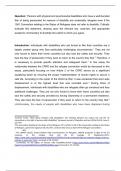Exam (elaborations)
Disabled Persons Right in Refugee Law
- Module
- LPC - Legal Practice Course
- Institution
- LPC - Legal Practice Course
This essay aims to examine the rights of persons’ with disabilities who are a marginalized group of individuals, who have been forced to flee their countries under difficult circumstances. They represent themselves as an invisible group of individuals who are forced to leave their county in a dep...
[Show more]



